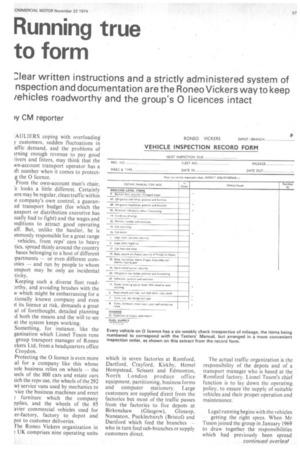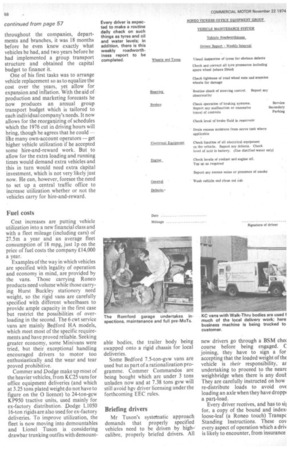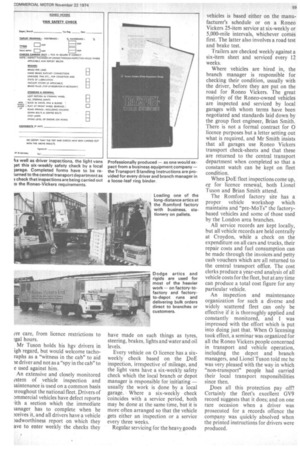Running true to form
Page 59

Page 60

Page 61

If you've noticed an error in this article please click here to report it so we can fix it.
clear written instructions and a strictly administered system of nspection and documentation are the Roneo Vickers way to keep rehicles roadworthy and the group's 0 licences intact
)y CM reporter
:AUL1ERS coping with overloading y customers, sudden fluctuations in affic demand, and the problems of trning enough revenue to pay good rivers and fitters, may think that the wn-account transport operator has a )ft number when it comes to protect.g the 0 licence.
From the own-account man's chair, 7e looks a little different. Certainly iere may be regular, clean traffic within ie company's own control, a guaraned transport budget (for which the ansport or distribution executive has ;ually had to fight) and the wages and mditions to attract good operating aff. But, unlike the haulier, he is munonly responsible for a great range vehicles, from reps' cars to heavy tics, spread thinly around the country bases belonging to a host of different :partments — or even different commies — and run by people to whom Ansport may he only an incidental tivity.
Keeping such a diverse fleet road3rthy, and avoiding brushes with the w which might be embarrassing for a Itionally known company and even it its licence at risk, demands a great al of forethought, detailed planning :d both the means and the will to see at the system keeps working.
Something, for instance, like the ganisation which Lionel Tuson runs group transport manager of Roneo ckers Ltd, from a headquarters office Croydon.
Protecting the 0 licence is even more al for a company like this whose tole business relies on wheels — the leers of the 800 cars and estate cars iich the reps use, the wheels of the 292 wt service vans used by mechanics to wice the business machines and erect
furniture which the company pplies, and the wheels of the 85 avier commercial vehicles used for er-factory, factory to depot and pot to customer deliveries.
The Roneo Vickers organization in .! UK comprises nine operating units which in seven factories at Romford, Dartford, Crayford, Kirkby, Hemel Hempstead, Scissett and Edmonton, North London produce office equipment, partitioning, business forms and computer stationery. Large customers are supplied direct from the factories but most of the traffic passes from the factories to five depots at Birkenshaw (Glasgow), Glossop, Nuneaton, Pucklechurch (Bristol) and Dartford which feed the branches — who in turn feed sub-branches or supply customers direct.
The actual traffic organization is the responsibility of the depots and of a transport manager who is based at the Romford factory. Lionel Tuson's chief function is to lay down the operating policy, to ensure the supply of suitable vehicles and their proper operation and maintenance.
Legal running begins with the vehicles getting the right specs. When Mr Tuson joined the group in January 1969 to draw together the responsibilities which had previously been spread continued overleaf throughout the companies, departments and branches, it was 18 months before he even knew exactly what vehicles he had, and two years before he had implemented a group transport structure and obtained the capital budget to finance it.
One of his first tasks was to arrange vehicle replacement so as to equalize the cost over the years, yet allow for expansion and inflation. With the aid of production and marketing forecasts he now produces an annual group transport budget which is tailored to each individual company's needs. It now allows for the reorganizing of schedules which the 1976 cut in driving hours will bring, though he agrees that he could — like many own-account operators — get higher vehicle utilization if he accepted some hire-and-reward work. But to allow for the extra loading and running times would demand extra vehicles and this in turn would need extra capital investment, which is not very likely just now. He can, however, foresee the need to set up a central traffic office to increase utilization whether or not the vehicles carry for hire-and-reward.
Fuel costs
Cost increases are putting vehicle utilization into a new financial class and with a fleet mileage (including cars) of 27.5m a year and an average fleet consumption of 18 mpg, just lp on the price of fuel costs the company £14,000 a year.
Examples of the way in which vehicles are specified with legality of operation and economy in mind, are provided by the vans. Those carrying Roneo products need volume while those carrying Hurst Buckley stationery need weight, so the rigid vans are carefully specified with different wheelbases to provide ample capacity in the first case but restrict the possibilities of overloading in the second. The 6 cwt service vans are mainly Bedford HA models, which meet most of the specific requirements and have proved reliable. Seeking greater economy. some Minivans were tried, but their exceptional handling encouraged drivers to motor too enthusiastically and the wear and tear proved prohibitive.
Commer and Dodge make up most of the heavier vehicles, from K C25 vans for office equipment deliveries (and which at 3.25 tons plated weight do not have to figure on the 0 licence) to 24-ton-gcw K P950 tractive units, used mainly for ex-factory distribution. Dodge L1050 16-ton rigids are also used for ex-factory deliveries. To improve utilization, the fleet is now moving into demountables and Lionel Tuson is considering drawbar trunking outfits with demount able bodies, the trailer body being swapped onto a rigid chassis for local deliveries.
Some Bedford 7.5-ton-gvw vans are used but as part of a rationalization programme. Commer Commandos are being bought which are under 3 tons unladen now and at 7.38 tons gvw will still avoid hgv driver licensing under the forthcoming EEC rules.
Briefing drivers
Mr Tuson's systetnatic approach demands that properly specified vehicles need to be driven by highcalibre, properly briefed drivers. All new drivers go through a BSM chef course before being engaged. C joining, they have to sign a for accepting that the loaded weight of thc vehicle is their responsibility, ar undertaking to proceed to the neare weighbridge when there is any dout They are carefully instructed on how re-distribute loads to avoid ove loading an axle when they have droppt a pan-load.
Every driver receives, and has to sij for, a copy of the bound and index' loose-leaf (a Roneo touch) Transpc Standing Instructions. These cov every aspect of operation which a driv is likely to encounter, from insurance ire care, from licence restrictions to gal hours.
Mr Tuson holds his hgv drivers in igh regard, but would welcome tachoraphs as a "witness in the cab" to aid le driver and not as a "spy in the cab" to e used against him.
An extensive and closely monitored vstem of vehicle inspection and laintenance is used on a common basis iroughout the national fleet. Drivers of Dmmercial vehicles have defect reports rith a section which the immediate ianager has to complete when he :ceives it, and all drivers have a vehicle )adworthiness report on which they ave to enter weekly the checks they have made on such things as tyres, steering, brakes, lights and water and oil levels.
Every vehicle on 0 licence has a sixweekly check based on the DoE inspection, irrespective of mileage, and the light vans have a six-weekly safety check which the local branch or depot manager is responsible for initiating — usually the work is done by a local garage. Where a six-weekly check 'coincides with a service period, both may be done at the same time, but it is more often arranged so that the vehicle gets either an inspection or a service every three weeks.
Regular servicing for the heavy goods vehicles is based either on the manufacturer's schedule or on a Roneo Vickers 25-item service at six-weekly or 5,000-mile intervals, whichever comes first. The latter also involves a road test and brake test.
Trailers are checked weekly against a six-item sheet and serviced every 12 weeks.
Where vehicles are hired in, the branch manager is responsible for checking their condition, usually with the driver, before they are put on the road for Roneo Vickers. The great majority of the Roneo-owned vehicles are inspected and serviced by local garages with whom terms have been negotiated and standards laid down by the group fleet engineer, Brian Smith. There is not a formal contract for 0 licence purposes but a letter setting out what is required, and Mr Smith insists that all garages use Roneo Vickers transport check-sheets and that these are returned to the central transport department when completed so that a constant watch can be kept on fleet condition.
When DoE fleet inspections come up, eg for licence renewal, both Lionel Tuson and Brian Smith attend.
The Romford factory site has a proper vehicle workshop which maintains and "pre-MoTs" the factorybased vehicles and some of those used by the London area branches.
All service records are kept locally, but all vehicle records are held centrally at Croydon, while a check on the expenditure on all cars and trucks, their repair costs and fuel consumption can be made through the invoices and petty cash vouchers which are all returned to the central transport office. The cost clerks produce a year-end analysis of all vehicle costs for the fleet, but at any time can produce a total cost figure for any particular vehicle.
An inspection and maintenance organization for such a diverse and widely scattered fleet can only be effective if it is thoroughly applied and constantly monitored, and I was impressed with the effort which is put into doing just that. When 0 licensing took effect, a seminar was organized for all the Roneo Vickers people concerned in transport and vehicle operation, including the depot and branch managers, and Lionel Tuson told me he was very pleased with the way in which "non-transport" people had carried their local transport responsibilities since then.
Does all this protection pay off? Certainly the fleet's excellent 0V9 record suggests that it does; and on one rare occasion when a driver was prosecuted for a records offence the company was quickly absolved when the printed instructions for drivers were produced.




















































































































